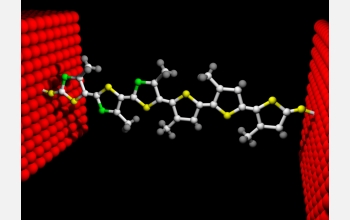|

Press Release 06-053
Device Only Atoms Across May Allow Infinitesimal But Powerful Computers

Single-molecule diode may change Moore's "law" of microchip memory
April 3, 2006
Using the power of modern computing combined with innovative theoretical tools, an international team of researchers has determined how a one-way electrical valve, or diode, made of only a single molecule does its job.
Diodes are critical components within computer, audio equipment and countless other electronic devices. If designers can swap existing diodes with the single-molecule one, the products could be shrunk to incredibly small sizes.
The technology may allow computer designers to sustain "Moore's Law"--a prediction made by Intel co-founder Gordon Moore in 1965--which suggested technological advances will allow a doubling every 18 months in the number of transistors that can fit on a computer chip. But the "law" has been nearing the end of its useful life as ever-shrinking silicon chips approach their physical limits.
Created by a research team at the University of Chicago, the single-molecule diode is merely a few tens of atoms in size and 1,000 times smaller than its conventional counterparts. Recently, theorists from the University of South Florida and the Russian Academy of Sciences have explained the principles that make the device work.
The researchers showed electron energy levels in a molecule are efficient channels for transferring electrons from one electrode to another. Because the molecule in the diode is asymmetrical, the electronic response is also asymmetrical when voltage is applied. The asymmetry contributes to a phenomenon called molecular rectification: the channels conduct electrons in one direction, but limit flow in the opposite direction when the voltage polarity reverses. That property makes the molecular diode a potential gatekeeper for circuits and a candidate to one day replace silicon in computer chips.
Researchers from all three institutions reported their findings in the March 10 issue of Physical Review Letters. The work was supported by several National Science Foundation grants.
Additional information is available in the press release linked below.
-NSF-

Media Contacts
Joshua A. Chamot, NSF (703) 292-7730 jchamot@nsf.gov
Randolph Fillmore, University of South Florida (813) 974-8476 Rfillmor@admin.usf.edu
Program Contacts
Mitra Basu, NSF (703) 292-8910 mbasu@nsf.gov
Maija M. Kukla, NSF (703) 292-4940 mkukla@nsf.gov
Andrew J. Lovinger, NSF (703) 292-4933 alovinge@nsf.gov
Co-Investigators
Luping Yu, University of Chicago (773)702-8698 lupingyu@uchicago.edu
Ivan Oleynik, University of South Florida (813) 974-8186 oleynik@shell.cas.usf.edu
Related Websites
Ivan Oleynik homepage: http://www.cas.usf.edu/physics/oleynik.html
University of South Florida press release: http://usfnews.usf.edu/page.cfm?link=article&aid=1196

The National Science Foundation (NSF) is an independent federal agency that
supports fundamental research and education across all fields of science and
engineering, with an annual budget of $6.06 billion. NSF funds reach all 50
states through grants to over 1,900 universities and institutions. Each year,
NSF receives about 45,000 competitive requests for funding, and makes over
11,500 new funding awards. NSF also awards over $400 million in
professional and service contracts yearly.
 Get News Updates by Email Get News Updates by Email
Useful NSF Web Sites:
NSF Home Page: http://www.nsf.gov
NSF News: http://www.nsf.gov/news/
For the News Media: http://www.nsf.gov/news/newsroom.jsp
Science and Engineering Statistics: http://www.nsf.gov/statistics/
Awards Searches: http://www.nsf.gov/awardsearch/
| 


